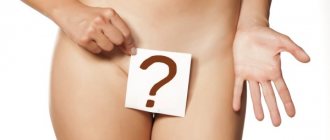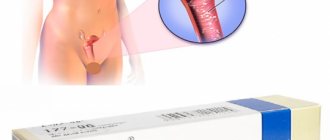Candida infections for the male half of humanity are not such a common occurrence, but representatives of the stronger sex often ignore any manifestations of the disease and are prone to self-medication. Due to such neglect, chronic thrush in men may soon develop, which is much more difficult to get rid of.
Fungi, which can only be seen with a microscope, lead to the development of disease in different parts of the body: candida feels equally confident on the skin and nails, but is most comfortable on the mucous membranes of the genital organs.
Mostly, the age of patients with thrush is between 15-45 years.
Some men remain carriers of harmful flora for many years, unaware that candida is slowly destroying their genitourinary system. In a number of clinical cases, candidiasis carriage passes almost immediately into the chronic phase.
Signs of thrush in men
Thrush in men is a fungal disease, most often caused by fungi of the genus Candida. Until a certain point, these bacteria do not cause any harm to the body. And they begin to reproduce intensively against the background of reduced immunity or after infection.
Thrush in men in the first stages is often asymptomatic or with mild symptoms. Only without timely treatment does the infection begin to manifest itself with significant symptoms and constant anxiety. Depending on the area of localization, genital candidiasis comes in several types: candidal urethritis, balanoposthitis, and pyelocystitis.
Common, pronounced signs of thrush include:
- the foreskin (or glans penis) becomes inflamed, where redness and swelling appear;
- urination is accompanied by a burning sensation, as well as pain;
- painful sexual intercourse and the erection itself;
- the formation of a dense coating of gray-white color and a sour odor.
This symptomatology may indicate the presence of thrush itself, as well as its combination with other hidden infections of the genital organs.
Up to 15% of men are asymptomatic. Candidiasis in these cases does not show any signs, but is easily transmitted to a partner.
Candidal urethritis
The fungus infects the mucous membrane of the male urethra. Symptoms are similar to those of acute gonorrhea. Candida urethritis manifests itself with the following symptoms: swelling, redness, itching and burning. Frequent urination, accompanied by a burning sensation and pain, should alert you. The urine itself often contains blood and, in some cases, copious amounts of mucus. After waking up, a man can observe a whitish thick discharge that forms into long threads.
Candidiasis balanoposthitis
Inflammations that appear on the head of the penis are called balanitis. If lesions appear on the inner layer of the foreskin, this will indicate the presence of posthitis. The combination of these two diseases is called balanoposthitis. Most often it is caused by the activity of Candida fungi, as well as when other sexually transmitted infections (genital herpes, trichomoniasis, gonorrhea, mycoplasmosis or chlamydia) are associated.
The following symptoms are characteristic of balanoposthitis with thrush:
- an unpleasant odor appears, reminiscent of sour milk;
- in the area of the foreskin and glans penis, a pasty white-gray coating forms (when it is removed, bleeding erosions may open);
- manifestation of edema on the foreskin and glans;
- severe hyperemia of the skin of the penis (redness appears without clear contours);
- In the affected area, irritation of nerve endings regularly occurs, which increases libido, but sexual intercourse itself causes discomfort, pain and discomfort.
The first symptoms of inflammation should prompt you to seek help from a dermatologist, skin venereologist and urologist. This will make it possible to establish an accurate diagnosis and, accordingly, select the correct treatment regimen.
Candidal pyelocystitis
This type of thrush is considered a complication in the absence of timely treatment. The infection affects the urinary tract, penetrating the bladder and kidneys. The disease manifests itself as pyelonephritis or cystitis. If pain was previously felt only during urination and sexual intercourse, now it will spread to the area of the kidneys and bladder.
Candidal pyelocystitis most often manifests itself in mixed infections, when infectious agents of gonococci, Escherichia coli, chlamydia, enterobacteria, etc. are added to fungi.
All of the above symptoms may be accompanied by fever and deterioration in general condition.
Consequences
Men mistakenly consider thrush to be harmless, but if the disease is neglected, the consequences of the chronic form will not take long to appear:
This process consists of the gradual growth of connective tissue in the vacated areas of epithelial cells destroyed by candida. New tissues lose their elasticity and do not stretch at the proper level, so the shape and functions of organs that have undergone sclerosis change.
Chronic thrush leads to the formation of scars on the foreskin, which ends with a narrowing of the area (this is called phimosis). Even with successful treatment in the future, this change persists.
Due to the narrowed foreskin, another unfavorable situation arises - pinching of the head. Patients with paraphimosis require emergency medical care (this involves surgery). In the absence of this, the strangulated tissues quickly die.
The chronic inflammatory process changes the structure of the urethra: it swells, and neoplasms appear in it in the form of benign granulomas. Because of this, the natural flow of urine is disrupted, and the opening in the urethra becomes narrower. Urine can no longer leave the body freely and stagnates, causing new infectious processes. These disorders can be persistent.
- Spread of candidiasis to some internal organs
The ascending path in the chronic form is not so uncommon. If candida moves in this way, it attacks the patient's bladder and kidneys, leading to pyelocystitis. The nature of this disease is often misdiagnosed and the disease is treated with antibiotics, which leads to further growth of candida.
- Penetration of harmful bacteria
Thrush, especially chronic, significantly worsens the state of local immunity, so men can become victims of pathogens and more serious diseases of the delicate genitourinary area.
Fungi can also affect the prostate; moreover, due to changes in the nature of the urethra, not only the outflow of urine is disrupted, but also the process of ejaculation. The prostate ducts can become clogged, leading first to vesiculitis and then to prostatitis. Male strength is under threat.
Due to regular exposure to fungal agents on the nerve endings, loss of sensitivity occurs in the intimate area. The feeling of orgasms is disrupted, and impotence gradually develops.
Why does thrush occur in men?
Thrush in men often indicates a malfunction of the immune system. If a man is healthy and has a strong immune response, recovery occurs quickly. It will be enough to use antifungal drugs for about a week. In some patients with a strong immune response, experts also observe self-healing. This is explained by the special structure of the genital organs. An infection that has entered the genital organ is washed out during urination, and there is no convenient place for its development (for example, like in the vagina).
Among the factors contributing to the proliferation of the fungus are:
- Psycho-emotional stress for a long period, as well as periodic severe stress.
- The presence of diseases that greatly reduce immunity. This could be anemia, cancer, blood diseases, etc.
- Hypothermia.
- Long-term use of antibiotics to combat other diseases, as well as corticosteroids.
- The presence of endocrine diseases in the form of hypothyroidism, diabetes mellitus type 1 and 2, as well as reduced body tolerance to glucose. In men, diabetes mellitus is often accompanied by hyperhidrosis - disturbances in the sweating process. Thus, human skin almost always has high humidity, and this contributes to the intensive proliferation of the fungus.
- Lack of microelements and vitamins.
- Men with excess weight problems, metabolic disorders and obesity have too much subcutaneous fat, which serves as an excellent place for the development of candidiasis.
During pregnancy
In pregnant women, fungal disease is very common; every second woman suffers throughout her entire pregnancy. Female sex hormones are to blame for everything, which reduce immunity and the activity of leukocytes. This contributes to the rapid proliferation of fungus in the birth canal. So how long does it take to treat thrush during pregnancy? Unfortunately, this fungal infection may only go away after childbirth. Your doctor may prescribe you pimafucin, which you can take during pregnancy. The most important thing is that it does not harm the baby. You should not self-medicate in this situation. You may be prescribed multivitamins and general health supplements.
Incubation period of thrush in men
How long does it take for thrush to appear in men after infection?
Typically, these periods are 2–7 days, but some patients may not pay any attention to minor redness that appears on the head of the penis. Sometimes these redness appear for a few minutes, for example, after drinking alcohol. A man can associate such manifestations with the consumption of foods to which the body reacted.
Drug treatment of thrush in men
It is possible to cure an infection effectively and quickly only with an integrated approach, which consists of: a healthy lifestyle, a special diet, and taking medications. The initial stage responds well to treatment using creams and ointments, but for the chronic form you will need capsules and tablets.
Crema
The following drugs have proven effective in the fight against fungal infections.
- Cream "Triderm". The composition includes betamethasone, gentamicin and clotrimazole. Copes well with irritation and itching. The cream is used for 2–5 days, 2 times a day. Side effects include a burning sensation and erythema (redness of the mucous membrane). Contraindications – cannot be used for chickenpox, skin tuberculosis, herpes, or on open wounds.
- Cream "Pimafucin". The main active ingredient is the antibiotic natamycin. Used topically 2–4 times/day for 1–2 weeks. The frequency of administration will depend on the severity of the disease. There are no contraindications.
- Cream "Terbizil". Has an effective antifungal effect. It is used in the morning and evening with a duration of 2-3 weeks.
Creams and ointments are applied only after hygiene procedures. Soap for these procedures is used without dyes or fragrances.
Ointments are more often prescribed for advanced forms of thrush in men and are used in combination with other drugs. Most often prescribed:
- Complicated forms of candidiasis are effectively treated with Nistanin ointment. Slight absorption of the product into the skin allows it to destroy the fungus. The drug is used for 10 days. Apply to damaged tissue 3 times a day.
- Clotrimazole ointment perfectly fights fungal infections and eliminates symptoms in a couple of days, but use should continue after the symptoms disappear. The duration of treatment is from 7 to 21 days.
Taking pills
Medicines for thrush in men in the form of tablets and capsules are prescribed exclusively by a specialist. Most often prescribed:
- "Fluconazole" The drug is available in capsule form. Allows you to get rid of the problem within 4-5 days. The prescription and dosage are determined only by the doctor, since taking Fluconazole can have a detrimental effect on the liver, and if it is overdosed, negative consequences may appear.
- A good alternative to Fluconazole is Itraconazole. The drug has fewer contraindications, but treatment can take up to seven days. The daily intake should not exceed 200 mg.
- The drug "Flucostat" is prescribed by specialists at any stage of infection development, only the required norm is calculated. For the initial stage of the disease, one tablet (or capsule) is enough. In more advanced forms, 1 capsule is prescribed for the 2nd day and for two weeks. The drug is also effective in chronic forms of infection. Prescribed 1 tablet per month for a year. Side effects include rash, nausea and dizziness. There are also contraindications: individual intolerance, liver disease, and heart problems.
Candidiasis in wife and husband
When the Candida fungus is actively multiplying, treatment of thrush in men and women should come to the fore. The fungus itself is harmless and is present in small quantities in any healthy body.
We can talk about a disease when the proliferation of a fungal infection is uncontrolled and causes negative consequences.
If in a married couple one of the partners develops symptoms of thrush, the disease will begin to progress in both, so it is important to treat the husband and wife at the same time.
Causes of thrush in husband and wife
Thrush in women and men develops for various reasons, the main of which is a decrease in the protective properties of the immune system.
It is known that various microorganisms and fungi, including the genus Candida, live in the body of a healthy person and participate in vital processes.
But it happens that the body’s protective functions weaken, and then the pathogen becomes active, multiplies quickly, causing symptoms characteristic of the disease. This is how thrush manifests itself, which, with inadequate treatment, passes from partner to partner.
The sick partner will be the carrier of thrush, and if the disease is detected in a girl or her boyfriend, both partners must undergo treatment for candidiasis, since in adults the pathology is primarily transmitted sexually. The disease can develop due to partner incompatibility, but then, in addition to thrush, the woman will be bothered by problems with the genitourinary system and constant inflammatory complications.
Symptoms in women
Vaginal discharge has an unpleasant odor.
If the carrier is a woman, the symptoms of the disease are pronounced, and if characteristic signs are present, it is worth visiting a doctor and undergoing joint treatment with your husband. Symptoms typical for women are as follows:
- on the outer labia and inside the vagina there is a white, curd-like discharge that has an unpleasant odor;
- due to the negative effect of the fungus on mucous tissues, swelling, irritation, itching, burning and discomfort develops;
- micro-wounds appear on the skin, the complication does not go away if treatment is not started in time;
- when trying to urinate, a woman experiences pain and discomfort;
- sexual intercourse becomes painful, and with severe inflammation, new wounds appear that bleed and itch.
Symptoms in men
In a guy, thrush manifests itself with no less pronounced symptoms, namely:
- swelling of the foreskin of the genital organ;
- redness, itching and peeling;
- the appearance of a bad odor;
- pain and discomfort during sexual intercourse;
- the presence of a white coating on the head of the penis, which appears again after removal.
Diagnostics
To determine an accurate diagnosis, you need to undergo a series of laboratory tests.
In order to successfully treat thrush in a married couple and prevent it from becoming chronic, it is important for both partners to undergo a diagnostic test, the main purpose of which is to determine the presence of Candida fungus in the body.
Before taking laboratory tests, it is forbidden to perform hygiene procedures the day before; men should refrain from urinating 2.5-3 hours before taking the material. The following samples should be taken from both partners:
| In a woman | In a man |
|
|
PCR diagnostics can help identify the DNA of the fungus, and it will be possible to determine the presence in the body of not only candidiasis, but also diseases caused by other types of fungi. A bacterial culture from the vagina will help identify the causative agent of candidiasis, as well as its susceptibility to antifungal drugs that will be used in treatment.
Do both partners need treatment?
If the disease is not treated in both partners at the same time, the risk of dangerous complications increases, after which the woman will not be able to get pregnant, and men will experience inflammatory complications of the genitourinary organs.
If one of the partners is not completely cured, the disease enters the chronic stage.
It is important to treat thrush in men and women in family relationships, since untreated male thrush will provoke a relapse in a woman, even if she strictly followed the course of treatment and took the medications prescribed by the doctor.
While the woman was undergoing treatment and the man was not taking medications, the fungus still “lived” on the male genital organs.
After the first unprotected sexual intercourse, a woman becomes infected again, but then it will be much more difficult to cure the problem, since the disease becomes chronic, the thrush becomes transient, and then it is not easy to get rid of it.
Treatment options
Thrush in girls and boys must be treated comprehensively; the doctor prescribes the medicine after studying laboratory data and making an accurate diagnosis. Women are better off using tablets and intravaginal suppositories. Good remedies for fungal infections are:
- "Pimafucin";
- "Gyno-Daktarin";
- "Gyno-Travogen";
- "Terzhinan";
- "Livarol";
- "Polygynax".
Men are recommended to use antifungal cream, ointments, and effective oral tablets, which should be taken according to the regimen prescribed by the doctor. The list of drugs that help get rid of thrush in men is as follows:
- "Ketoconazole";
- cream "Clotrimazole";
- "Candidbene";
- "Candide";
- "Mikosist";
- "Nizoral."
Systemic treatment
The disease can be cured once and for all with the help of complex therapy.
It is important to take some tablets for thrush in courses, and some are enough to take for one or two days.
For example, a remedy such as Flucostat, which is an effective and efficient drug, helps get rid of candidiasis after a one-time use, but provided that the disease occurs at an early stage.
And also such tablets as “Diflucan”, “Mycostit”, “Pimafucin”, “Fluconazole” are often used.
In addition to medications, they are treated with folk remedies based on decoctions and herbal infusions. The remedies must be done daily; the most commonly used herbs are chamomile, St. John's wort, oak bark, calendula, lavender, juniper.
It is important and necessary to treat your partner for thrush, because one can always infect the other, and this will happen all the time, like a vicious circle. If you get sick, it is important to tell your partner about the problem and go to the doctor together for an appointment. A correct diagnosis and an adequately selected treatment regimen are the key to successful treatment for both partners.
Source: https://EtoGribok.ru/molochnica/vidy/u-zheny-i-muzha.html
Treatment with folk remedies
Treatment of thrush in men at home can be carried out only in the initial stages of infection. It is better to entrust more advanced forms to a doctor.
Traditional medicine pays special attention to chamomile. This plant has many beneficial properties, including antifungal and antibacterial effects. Dry chamomile inflorescences are used in the form of infusions that can be used to wipe the affected areas. To prepare the infusion 2 tbsp. spoons of flowers are poured with 200 ml of boiling water. The genitals are treated with the already cooled infusion 5-6 times a day. In addition, you can use chamomile in combination with calendula, which also has antibacterial and healing properties.
Tea tree oil will help quickly eliminate symptoms and combat fungus. Fifteen drops of the product are diluted in a liter of warm water. Soak gauze in the resulting mixture and then apply it to the affected areas for 5 minutes. It is recommended to repeat the procedure 1-2 times/day.
Duration of treatment
How long does thrush last in men? The answer to this question will depend on the stage of infection. If the disease was detected at an early stage, and the patient began treatment on time and followed all the doctor’s recommendations, thrush can be cured in 4–6 days. More advanced forms may take weeks to treat.
With proper treatment, male thrush goes away without any consequences for the body, but this requires: seek help in time, stop sexual intercourse until both partners are completely recovered, adhere to proper nutrition, and lead a healthy lifestyle.
What questions should the buyer ask?
When you are asked to give something for thrush, you do not need to immediately offer an antimycotic. Talk to the customer. Why did she think it was thrush?
Questions could be:
- Did your doctor give you this diagnosis?
- How does the disease manifest? Is there itching, burning, or pain when urinating? What kind of discharge? (interested in color, consistency). White, curdled ones are thrush. If others, then the big question is what it is. Possibly an STD, and it makes no sense to recommend Fluconazole.
- Is this your first time, or have you already had similar symptoms? If you have already had thrush, find out how often exacerbations occur.
Thrush in men: symptoms and how long it takes to treat
A disease such as thrush affects both women and men. However, how long does it take to treat thrush in men, because in women it can be fought from several days to several years, depending on the form of the disease. It is generally accepted that a disease such as thrush occurs exclusively in females. However, this is a misconception; there are cases of men being affected by this insidious fungus. Although it is worth noting that this happens much less frequently than in women, it is still quite possible, especially against the background of a weakened immune system or taking strong antibiotics.
Treatment regimen for both partners
A doctor can determine what a woman and her partner should take for thrush only after a thorough examination of both partners. The main goals of therapy: eliminate the causative agent of the pathological process and risk factors that provoke candidiasis, restore the immunological activity of the body. The general treatment regimen includes the use of the following medications:
- combined aminoglycosides;
- antiseptics;
- immunomodulators;
- probiotics;
- interferon inducers;
- antifungal agents, including those with a combined composition;
- probiotics;
- vitamin complexes;
The doctor prescribes medications individually for each patient, taking into account age, physiological characteristics (pregnancy), and the presence of concomitant disorders.
A man needs to visit a urologist and find out how to treat thrush if it is detected in a woman with whom he is sexually active.
To choose a suitable treatment regimen for thrush, the doctor takes into account the following factors:
- reason for the violation;
- clinical form of candidiasis;
- degree of spread of the disease;
- the presence of general and local predisposing factors.
If there are obvious symptoms of candidiasis, therapy is prescribed without laboratory diagnostics. However, in case of recurrent processes, a study is carried out to determine the sensitivity of fungi to the active ingredients of antimycotic drugs.
Balanced health will help speed up your recovery.
To enhance the effectiveness of treatment, it is recommended to follow a diet: avoid bread, sugar, fructose, milk, alcoholic beverages, and excessively spicy, fatty, and salty foods.
Causes of thrush
Thrush is caused by a fungus called Candida, which is normally present in the body of any healthy person. But when internal organs malfunction, the immune system is weakened, or strong antibiotics are taken, the microflora is disrupted and the fungus begins to grow rapidly, capturing the affected areas and trying to grow as deep and far as possible throughout the body.
Men suffering from diabetes and obesity are at risk. It is known that in diabetes mellitus, yeast can involuntarily increase in number due to high blood sugar.
In addition, a man can become infected if his partner has vaginal candidiasis. In this case, the chance of infection is very high.
Features of sexual life during menopause.
- Intimate life and menopause
- Physiology of menopause and sex
- Psychological changes during menopause
- Protection during menopause
- Improving intimate life during menopause
Sexual intercourse allows a man and a woman to get closer and relieve psychological and physiological stress. But at a certain period, changes occur in a woman’s body that affect her genital area. Menopause is coming.
Some couples think that when these changes begin, sexual intercourse becomes a problem. But menopause and its consequences do not pose a threat to a couple’s sexual relationship. Intimate life changes, but does not disappear.
Physiological changes in a woman’s body are based on a decrease in the amount of the female sex hormone – estrogen. It is responsible for sexual desire and the functioning of the reproductive system as a whole. When it is missing, sexual intercourse becomes less vibrant.
Such changes make a woman feel psychological discomfort. This can trigger feelings of inferiority, depression, withdrawal, or other problems.
A normal amount of estrogen regulates the activity of a woman’s genital organs and helps cells grow and repair properly. The pelvic organs receive sufficient oxygen due to proper blood circulation.
After the onset of menopause, these indicators decrease. If a woman leads a passive lifestyle, then stagnation in the pelvis is guaranteed. This can lead to problems with the elasticity of the vagina and uterus, which has a negative impact on sexual intercourse.
A lack of estrogen makes the reproductive system more vulnerable to diseases and infections. During this period, women's diseases may worsen or recur. Because of this, older ladies need to carefully monitor their health. Consulting a gynecologist on these issues will help you understand yourself and eliminate the problem in time.
In addition to the existing changes in a woman’s body, problems with moral health may be added. Because of this, married couples are recommended to study together in detail the features of menopause and its consequences. The participation of the woman's sexual partner in this process is an important factor.
A man should be aware of a woman’s changes and their consequences during menopause. The possibility of maintaining a rich and regular sex life depends on his attitude towards his partner.
Tags: if, wife, treatment, thrush, necessary About the author: Admin4ik
« Previous entry
Prevention and treatment
When the first symptoms of thrush appear, you should consult a doctor. There are cases when similar symptoms occur in some types of sexually transmitted infections. In this case, it is necessary to accurately determine the diagnosis using penile smear tests.
After diagnosing thrush, the doctor will prescribe an ointment containing fluconazole, a substance that has a detrimental effect on the Candida fungus. If relapses of the disease occur several times a year, then we are talking about a chronic manifestation of candidiasis, and in addition to ointments, oral medications are prescribed.
If both partners are infected, it is important to get treatment not only for the man, but also for the woman. Remember, only joint treatment will avoid recurrence of the disease in the future.
The best protection against candida infection is its prevention. It is necessary to carefully choose underwear, it should not be too tight, the fabric should be natural, it is advisable to use cotton fabric.
Carefully observe intimate hygiene, do not use soap or strong-smelling shower gels. Alkali can dry out the delicate skin of the head of the penis and cause irritation. It is necessary to wipe the head and foreskin of the genital organ dry to avoid the accumulation of moisture and the proliferation of Candida fungi.
If your partner gets thrush, it is best to avoid sexual intercourse until she is completely recovered or use a condom to prevent infection.
What do you need to remember?
- Thrush is a fungal disease that is not sexually transmitted.
- Thrush should be treated by both partners, even if one of them shows no signs of the disease.
- During therapy, antifungal drugs are used for local and systemic effects.
- Local remedies for women: suppositories and vaginal tablets, for men: creams.
- In addition to antifungal agents, the use of probiotics and vitamin complexes is recommended.
- In case of repeated relapses of thrush, laboratory diagnostics are carried out to determine the sensitivity of the fungi to the action of the active component of the drug.
Sources:
https://webmolochnica.ru/lechenie-molochnicy-u-muzhchin-zhenschin-preparaty.html https://endometriy.com/molochnitsa/chem-lechit-partnera https://ovulyacia.ru/problemy/molochnica/lechenie- wallpaper-partnerov
Basic rules for treating thrush
To treat fungal infections in men, drugs based on Imidazole are prescribed; this is an active substance that can destroy fungal spores and cure the disease in the shortest possible time.
Medicines containing imidazole include:
All these drugs can be freely purchased at any pharmacy without a doctor's prescription.
The treatment period for thrush in men lasts on average a week, it is important to combine the use of the cream with the ingestion of fluconazole tablets and genital hygiene, exclude sweet, fatty and spicy foods from the diet, then the recovery process will be much faster and more effective.
The most common side effect when taking imidazole-based medications is a slight tingling and burning sensation in the area of application. Usually it goes away quickly, but if it intensifies, it may be an allergic reaction to the drug. You need to see a doctor, he will prescribe another fluconazole-based medicine.
During treatment for thrush, it is necessary to stop sexual activity or use protection.
If a man cannot get rid of thrush within a week, then oral medications are prescribed. Typically, this method of combating thrush is highly effective.
The most common side effects when taking fluconazole are:
- bloating;
- excessive accumulation of gases in the rectum;
- attacks of nausea;
- stomach pain.
In the most advanced cases, when the growth of the fungus has affected most of the organs and penetrated into the internal organs of a person, not only local treatment is required, but also the intervention of a venereologist, and possibly even hospital treatment.
In any case, it is necessary to understand that when the first symptoms of the disease occur, treatment must be started immediately in order to prevent the development of a more severe form of candidiasis.
It is important to treat the infection to the end, otherwise thrush will develop into a chronic form and relapses will occur several times a year, making it much more difficult to get rid of the disease.
How long does it take to treat thrush?
It is worth noting that everyone’s illness lasts differently. For some it goes away within a few days, while for others it takes up to several weeks. In acute forms of the disease, treatment may take up to 1 week. The duration of treatment may depend on several factors - the localization of the process, the patient’s complaints and how severe the disease is.
If left untreated, it will go into a chronic stage. And then a more serious course of treatment will be prescribed. But it may also be useless until the girl strictly follows the doctor’s instructions. Remember that when thrush reaches the candidiasis stage, the treatment process will not be quick.
Doctors may prescribe you medications such as: Terzhinan, Klion-D or Clotrimazole. Suppositories-Polygynax and Livarol will also help. For quick treatment, you may be prescribed Neo-Penotran suppositories and tablets based on the drug fluconazole. For candidiasis, complex antifungal drugs will be prescribed.
Creams are prescribed to treat thrush in men. For example: Miconazole, Clotrimazole, Pimafucin. Apply to affected areas after a bath, 2-3 times a day. So, how many days does it take for thrush to go away in men? It goes away quite quickly, the symptoms disappear within 2-3 days.
Hygiene is the best defense against thrush
Many men neglect the daily hygiene of their genitals, and in vain. Bacteria accumulate in the foreskin of the male genital organ, and good cleansing must be done daily, if there was sexual intercourse, then after it too.
Candida fungus grows and multiplies in warm, moist environments, so it is important not only to thoroughly wash the penis, but also to wipe it dry.
Get into the habit of wearing only cotton underwear, without adding synthetics. Synthetic fiber does not allow the skin to breathe, creating a sauna effect, which is fraught with the growth of thrush fungus spores. The cut of the underwear should be loose; avoid tight-fitting or tight-fitting panties.
Possible complications of thrush in men
The risk group includes men with weakened immune systems due to previous or chronic diseases, such as diabetes, HIV, taking antidepressants, chemotherapy, dialysis.
All these procedures and diseases reduce the level of the body’s natural defenses, the fungus penetrates the blood and affects the internal organs. In this case, it is customary to talk about an invasive form of thrush. This type of disease is difficult to treat, although it is extremely rare.
In severe internal form of candidiasis, the following is observed:
- increase in body temperature up to 39 degrees;
- chills, dizziness;
- nausea, vomiting.
If such symptoms appear, you must immediately see a specialist for examination and surgical treatment. The thrush fungus is very insidious; it affects the internal organs of a person, covering them with a tight, thick white film. The body cannot cope with the infection on its own due to lack of immunity.
Complications after illness
The most dangerous complication of candidiasis in men is candidal sepsis. This disease develops when fungus enters the bloodstream. But such a complication occurs rarely and only when the immune system is weakened due to:
- AIDS and HIV;
- hemodialysis;
- diabetes mellitus;
- after transplantation;
- radiation therapy and chemotherapy;
- when installing a central venous catheter.
If the disease is not treated correctly or not treated at all, it will give the following complications:
- orchitis (the so-called inflammation of the testicles);
- acute prostatitis;
- urethral stricture (narrowing of the urinary tract);
- violation of the elasticity of the foreskin and its narrowing;
- Gangrene of the genital organ is less common.
Sepsis requires urgent medical attention because it can sometimes be fatal. Since candidiasis in men has symptoms similar to sexually transmitted diseases, treatment is prescribed only by a qualified specialist. Treatment of mild forms of pathology is carried out with folk remedies, but also only after consultation with a doctor.
Chronic candidiasis, or simply chronic thrush, is one of the stages of the development of a fungal infection in the human body. Many people call it chronic mucocutaneous candidiasis. This phrase is not a definition, but it accurately reflects the place of localization.
How many days does treatment for thrush last in men and women?
Vulvovaginal candidiasis is a genital infection, the etiological factor of which is the activation of opportunistic vaginal microflora, namely yeast-like fungi from the genus Candida. When visiting a gynecologist, every woman is concerned with the question of how long thrush lasts and how long it will take to treat it.
As a rule, the presence of thrush can be confirmed by characteristic complaints and the appearance of the vaginal mucosa, as well as by microscopy of a smear taken during a gynecological examination. Therefore, the most important thing is to start therapy in a timely manner to avoid chronicity of the process or the development of complications.
Why should candidiasis be treated for both partners?
Thrush is a fungal disease that is not a sexually transmitted disease. However, after sexual intercourse with a carrier of the infection, candidiasis can develop in his sexual partner. Therefore, when the first signs of thrush are detected, treatment of both sexual partners is recommended. During therapy, it is recommended to abstain from sexual intercourse. This is largely due to physical and psychological discomfort. Sexual intercourse increases itching, skin irritation, cheesy discharge, and pain. When the mucous membrane is thinned and injured, the risk of secondary infection increases.
The main cause of the disorder is the rapid growth and reproduction of its own opportunistic microflora (fungi). May be due to the following factors:
- hormonal imbalance;
- decreased local and general immunity due to hypothermia, deficiency of vitamins and microelements;
- poor nutrition: excessive consumption of sugar, simple carbohydrates, alcoholic beverages;
- uncontrolled use of antibacterial drugs that disrupt the natural balance of the friendly normal flora of the intestines and vagina.
Most of the yeast-like fungi are localized in the gastrointestinal tract. Candida is also often found in the oral cavity of women. During sexual intercourse with a Candida-carrying partner, the male genitals are also colonized by such fungi.
How long does thrush last on average and what does it depend on?
When answering the question of how many days does thrush go away, it is impossible to give a definite answer, since it depends on a number of factors:
- The state of the body's immune system. Reduced reactivity is not only the leading factor in the occurrence of candidiasis, but also determines the duration of its course.
- The duration of the period from the moment of illness to the start of therapy. If treatment is prescribed 24-48 hours after the appearance of the first complaints and signs, then the likelihood of a speedy recovery is much higher than with late-started therapy.
- The state of the vaginal microflora. If the development of candidiasis occurs against the background of vaginal dysbiosis, then treatment only with antifungal drugs without the use of lactobacilli will aggravate the course of thrush and complicate recovery.
- Background chronic pathology. Quite often, genital candidiasis occurs in women suffering from diabetes, chronic inflammatory diseases of the reproductive system, toxic goiter or immunodeficiency. Therefore, the duration of thrush also depends on the degree of compensation of the concomitant disease.
- Adequacy of the selected therapy. It is important not just to use an antifungal drug, you need to choose exactly the one to which the seeded fungi are sensitive.
- Compliance with recommendations and appointments. In order to shorten the duration of the disease, a woman should follow all the advice of her doctor.
If we do not take into account the above factors, the average duration of the acute form of thrush is 7-10 days, while chronic candidiasis can affect the physical condition of a woman for much longer.
How much is usually treated in women and men with the right approach?
Again, the duration of therapy depends on the degree of activity of the process and the severity of clinical manifestations. If we compare how long it takes to treat thrush in women and men, then in the first case the average duration of use of antifungal agents is 7-10 days, in the second - usually 10-14 days.
Basically, a woman with newly diagnosed acute primary thrush is prescribed a single dose of a fluconazole-based antifungal systemic drug (Flucostat or Diflucan) at a dose of 150 mg and a 7-10-day course of vaginal antimycotic suppositories.
For example, according to the official instructions, local suppositories with Hexicon antiseptic must be used for 10 days, one or two pieces per day. Intravaginal suppositories Clotrimazole are used for 6 days to treat acute candidiasis.
It is also possible for men to take Fluconazole once for systemic antifungal action. However, the standard course of treatment is as follows: two weeks of taking Nystatin tablets and local use of an antifungal ointment that is active against yeast-like fungi (Sebozol for 14 days or Miconazole for 14-21 days). It is important to treat not only the affected areas, but also the surrounding healthy skin.
The chronic form of thrush implies longer use of antifungal medications. For example, Flucostat is prescribed as follows: take one capsule every 4 weeks for 6-12 months. If vaginal tablets called Terzhinan are used, then the duration of therapy is not 10 (as in acute cases), but 20 days of daily use.
Do not forget about the diet, since thrush treatment necessarily includes a diet with the exception of quickly digestible carbohydrates. At the time of treatment, soaps and hygiene products with fragrances are not used. Sexual contact should be avoided while the thrush is being treated for several days.
Also, with a competent approach, the gynecologist will definitely prescribe a course of immunomodulators, vitamins and lactobacilli, which normalize the vaginal biocenosis. Typically, such complex therapy lasts 4-6 weeks.
Diagnostics
Doctors insist on an immediate examination by a specialist (gynecologist, urologist, or for children - pediatrician). Only a doctor can reliably establish a diagnosis after conducting preliminary studies.
Important! To ensure accurate tests, do not use any medications or hygiene products the day before. They can erase the clinical picture.
To navigate correctly, the doctor needs to:
- conduct an individual visual inspection;
- find out related illnesses;
- listen to the patient's complaints;
- obtain the result of a clinical (general blood and urine test), microscopic and bacteriological examination (smear).











